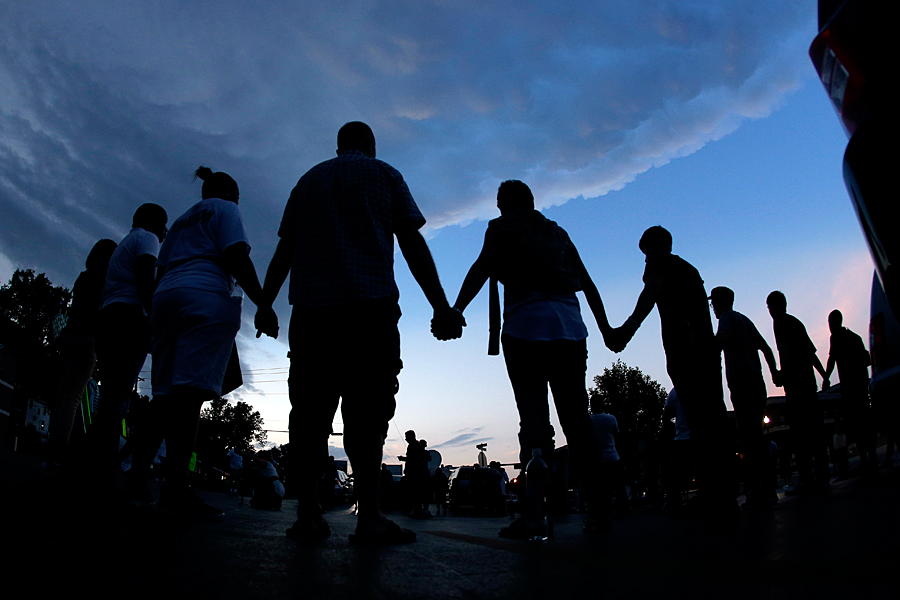Ferguson: How the balkanization of greater St. Louis fueled the strife
Loading...
| Atlanta
As normalcy begins to return to strife-torn Ferguson, Mo., there’s a rising awareness in a shocked and sad city that Ferguson and greater St. Louis need deep, political, and structural changes that, given a racist history, will be inordinately difficult to attain.
The televised, war-like clashes between protesters and riot police set off by the Aug. 9 police shooting of Michael Brown were frightening in an America that sometimes sees itself as post-racial. The tinderbox of pent-up anger seemed to touch on racial injustice in other cities, whether Chicago or Atlanta, including a deep sense – expressed by officials as high up as Attorney General Eric Holder – that the riots encapsulate “something that has a history to it … that simmers … in more communities than just Ferguson.”
At the same time, it’s notable that what happened in Ferguson can be tied to the uniquely balkanized political structure that binds – or, more accurately, divides – the 3 million residents of the greater St. Louis area.
For one, the Gateway to the West is actually nearly 400 distinct municipalities – including Champ, where 13 white people live – where segregation lines are so hard that there are in places actual street barriers – large concrete balls or gates – separating “bad” neighborhoods from “good.”
Moreover, St. Louis exists in a historical, geographical, and cultural gray zone, part Southern and part Northern, yet sharing precious little of those regions’ racial progress.
Writ large, it’s a seemingly intractable and parochial map where wealthier whites guard their nationally ranked school districts from the black kids who attend failing school districts like Normandy, where Michael Brown attended.
Municipal fragmentation in greater St. Louis “is like a sorting system, where everybody gets sorted by socioeconomic status” and where black opportunity is squelched, says Clarissa Hayward, who studies power and identity in urban America at Washington University in St. Louis.
“If there was a more unified system of governance, and children had access to the same educational system, governed by the same elected officials, we would have a different situation,” she says.
The roots of the riots run deep, even if you don’t count Missouri slave Dred Scott’s failed 1857 suit for freedom, denied by the Supreme Court. Political racism in St. Louis goes back to an 1876 decision by the city to “divorce itself from the county and close its borders,” says Ms. Hayward. “It seemed like a great idea because all the wealth and power was in the city, where people felt like the county was the country bumpkins who drained resources. In hindsight, it was a terrible decision.”
Hit hard by the decline of manufacturing and white flight, St. Louis, emptied of nearly half its inhabitants since its heyday, is reimagining itself, with neighborhoods like the Grove and Tower Grove South leading a hipster renewal. And for its part, Ferguson is one of the least segregated towns in urban St. Louis.
Yet there are few, if any, places in the US where the segregation lines run so hard. It’s not surprising, either. St. Louis has been at the forefront of every racially based zoning and covenant decision by the Supreme Court, dating to 1917.
“The impulse toward segregation is … unusually persisent in St. Louis, and then municipal fragmentation provides political opportunity to make it very real by chopping the county up in postage stamp municipalities,” says Colin Gordon, a University of Iowa historian and author of “Mapping Decline: St. Louis and the Fate of the American City.”
“So, as long as municipalities can play beggar thy neighbor,” he says, “you’re always going to get a plurality thinking they’re going to come out ahead.”
And poor blacks, research shows, shoulder the brunt of those consequences, whether it’s how they’re treated by developers, politicians, school officials, or cops.
A recent study by ArchCity Defenders, a legal aid group, found Ferguson particularly notable for “stopping black drivers disproportionately for traffic violations, fining them in court sessions that were closed to the public, and jailing them when they were unable to pay,” a pattern which has served to “destroy the public’s confidence in the justice system and its component parts.”
Evidence of the balkanization can be seen in the black-white wealth gap, which, while a national phenomenon, is particularly dire in the St. Louis area. According to Mr. Gordon, the average worth of a black personal estate in St. Louis is $800, while the average worth of a white estate is $80,000, the disparity being tied primarily to home equity.
St. Louis has attempted to de-balkanize before, including an idea floated last year to meld the disparate police departments under the St. Louis County umbrella to create more uniform training and hiring practices. All have failed, which is one reason why some black protesters are begging for federal intervention to balance what some see as a constitutional inequity.
“There’s a long history of attempts to put St. Louis and St. Louis County back together again, but no one wants to give up their parochial fiefdoms,” Gordon says.
There is some hope, says Clarence Lang, an American studies professor at the University of Kansas. Polling persistently shows 1 in 3 white Americans deeply sympathetic to black complaints about schools and policing – the kind of significant minority that changed the tide of the 1960s civil rights movement.
And more locally, the unrest has given St. Louis area residents, both black and white, an opportunity to address the history and reality of their city’s unique, and troubling, view of race, property, and hope.
“This is a reckoning,” says Mr. Lang.








